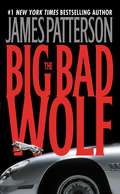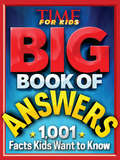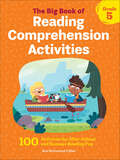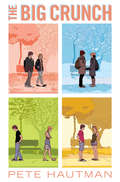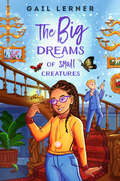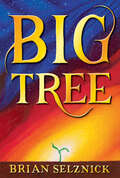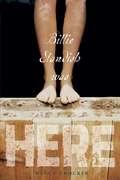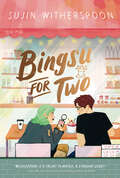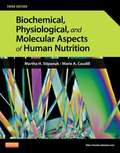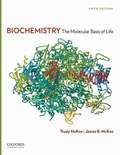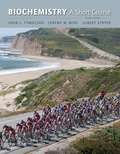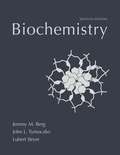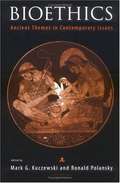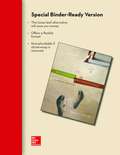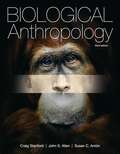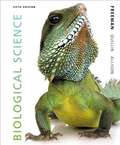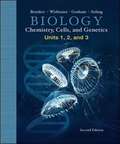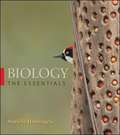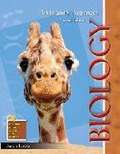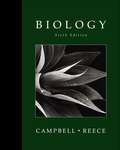- Table View
- List View
The Big Bad Wolf (Alex Cross #9)
by James PattersonAlex Cross's first case since joining the FBI has his new colleagues stymied. Across the country, beautiful women are being kidnapped-to be bought and sold as slaves. Behind this depraved scheme stands a shadowy figure known only as The Wolf, a master criminal who has brought a new reign of terror to organized crime. With Alex's personal life in chaos because of his ex-fiancée's return and with the FBI's caution testing his patience, Alex has to go out on his own. For to stalk a ruthless predator without a name or a face, Alex Cross must become a lone wolf himself...
Big Book of Answers: 1,001 Facts Kids Want to Know (Time For Kids Big Bks.)
by Editors of TIME For Kids MagazineIn a great new oversized format, TIME For Kids Big Book of Answers satisfies the most curious kids with answers to the questions they commonly ask but adults can rarely answer. Questions like ""How does popcorn pop?"", ""Where did the Titanic sink?"" and ""Why are our eyes different colors?"" are grouped into easy-to-navigate categories such as animals, humans, history, science and sports. Colorful photos, dynamic graphics, and simple text help kids discover 1,001 amazing facts to impress their parents, teachers, friends...and anyone else who will listen
The Big Book of Reading Comprehension Activities, Grade 5: 100 Activities for After-School and Summer Reading Fun (Reading Comprehension Activities)
by Ann Richmond FisherMake reading comprehension fun with 100 activities for 5th gradersWhen kids can learn cool new facts or go on fictional journeys with talking dragons and pirate ships, reading doesn't feel like homework—it feels like an adventure! This workbook is filled with exercises that help students practice core reading comprehension skills while exploring fun stories and ideas. Kids will learn essential 5th grade concepts like using context clues, integrating information from multiple sources, drawing inferences, and more.This reading comprehension workbook for 5th graders includes:A variety of activities—Keep kids engaged with word puzzles, drawing, matching games, and other creative exercises that make learning enjoyable.Core curriculum—This workbook is aligned with the national standards for 5th grade learning, complete with a label for each activity to indicate which core skill it teaches.Progressive skill-building—Students will strengthen their skills with reading comprehension exercises that start simple and grow more challenging.Boost reading comprehension skills with help from this fun-filled 5th grade workbook.
The Big Crunch
by Pete HautmanA funny, clear-eyed view of the realities of teenage love from National Book Award winner Pete Hautman.A funny, clear-eyed view of the realities of teenage love from National Book Award winner Pete Hautman.Jen and Wes do not "meet cute." They do not fall in love at first sight. They do not swoon with scorching desire. They do not believe that they are instant soul mates destined to be together forever. This is not that kind of love story.Instead, they just hang around in each other's orbits...until eventually they collide. And even after that happens, they're still not sure where it will go. Especially when Jen starts to pity-date one of Wes's friends, and Wes makes some choices that he immediately regrets.From National Book Award winner Pete Hautman, this is a love story for people not particularly biased toward romance. But it is romantic, in the same way that truth can be romantic and uncertainty can be the biggest certainty of all...
The Big Dreams of Small Creatures
by Gail LernerFrom Black-ish writer and director Gail Lerner comes a whimsical and heartwarming tale where two unlikely allies band together to protect and defend the insect world from the worst enemy of all…humans.&“What an enchanting and wondrous book for young readers.&” —Jamie Lee Curtis, actress and bestselling children&’s book authorTen-year-old Eden&’s quiet life is upended when she saves a paper wasp nest from destruction and discovers, to her awe and amazement, that she and its haughty queen can talk to each other. This first conversation is the start of a grand adventure, leading Eden to The Institute for Lower Learning, a secret laboratory devoted to the peaceful coexistence of humans and insects. The Institute is more fantastic and idyllic than Eden could&’ve imagined but hidden deep within its tunnels is an old secret that could spell the end for all insects on earth.Nine-year-old August, an aspiring actor and bullied fourth-grader, is looking for that very secret after a few disastrous encounters have left him wanting to squash every annoying bug into oblivion. After all insects are small—he is big. And if there is anything he&’s learned from the bullies at school—it's that being bigger is what counts.But in the world of the Institute where insects have a place of their own, both Eden and August discover being bigger isn't necessarily better and sometimes the most courageous thing to do is to set out to make a new friend.
Big Tree
by Brian SelznickThe fate of all life on Earth may depend on the bravery of two little seeds in this epic adventure from the #1 New York Times bestselling creator and Caldecott Medalist of The Invention of Hugo Cabret."The tale of the natural world is the greatest story we have to tell, and Brian delivers a brilliant chapter of that tale throughout the pages of Big Tree." - STEVEN SPIELBERG"We need brave, big stories like [Big Tree]." -The New York Times Book Review"Has the power to intrigue...affecting." - The Wall Street Journal* "An enthralling and expansive meditation on what it means to be alive on this planet." - Booklist, starred review* "A balanced and rich book. . . . Powerful."-The Bulletin of the Center for Children's Books, starred and recommended review* "In evocative prose and peppery dialogue . . . the cinematic story journeys across time and space, contemplating the power of life to heal." -Publishers Weekly, starred review* "A special, one-of-a-kind book for the whole family that readers won't soon forget." - School Library Journal, starred review* "Masterful." - The Horn Book, starred review"Inspirational, important, and beautiful. A fable for our times." - Alan Gratz, bestselling author of Refugee and Ground Zero"Hello, stars. I thought I heard you calling me."A mysterious voice has been speaking to Louise in her dreams. She and her brother Merwin are Sycamore seeds, who hope to one day set down roots and become big trees. But when a fire forces them to leave their mama tree prematurely, they find themselves catapulted into the unknown, far from home. Alone and unprepared, they must use their wits and imagination to navigate a dangerous world-filled with dinosaurs, meteors, and volcanoes!-and the fear of never finding a safe place to grow up. As the mysterious voice gets louder, Louise comes to realize their mission in life may be much bigger than either of them ever could have imagined!Brimming with humor, wonder, mystery, and a profound sense of hope, Big Tree is a trailblazing adventure, illustrated with nearly 300 pages of breathtaking pictures. It is Selznick's most imaginative and far-reaching work to date and a singular reading experience for the whole family.The audiobook edition of BIG TREE is brought magnificently to life by Meryl Streep and features music composed by Ernest Troost.
Billie Standish Was Here
by Nancy CrockerCAN ONE UNLIKELY FRIENDSHIP SAVE A LIFE? Billie Standish has pretty much no one. Her parents are too caught up in their own lives, and the only two girls in town her age want nothing to do with her. When it looks like a nearby levee might break, and Billie's elderly neighbor, Miss Lydia, is the only other person besides her family to stick around, a friendship is born out of circumstance. What happens during that time, in that empty town, is a tragedy that Billie can't bear alone. Can the love of one woman nearing the end of her life save the life of a young woman just at the beginning of living hers?
Bingsu for Two
by Sujin WitherspoonThis outrageously charming and infuriatingly adorable enemies-to-lovers coffee shop romance is perfect for fans of YA books by Jenny Han and Better Than the Movies. Meet River Langston-Lee. In the past 24 hours, he&’s dumped his girlfriend, walked out of his SATs, and quit his job at his parents&’ cafe in spectacularly disastrous fashion—even for him. Somehow, he manages to talk his way into a gig at a failing Korean cafe, Bingsu for Two, which is his lucky break until he meets short, grumpy, and goth: Sarang Cho. She&’s his new no-BS co-worker who&’s as determined to make River&’s life hell as she is to save her family&’s cafe. After River accidentally uploads a video of his chaotic co-workers to his popular fandom account, they strike viral fame. The kicker? Their new fans ship River and Sarang big-time. In order to keep the Internet&’s attention—and the cafe&’s new paying customers—River and Sarang must pretend that the tension between them is definitely of the romantic variety, not the considering the best way to kill you and hide your body variety. But when Bingsu for Two&’s newfound success catches the attention of River&’s ex and his parents&’ cafe around the corner, he faces a choice: keep letting others control his life or stand up for the place that&’s become home. And a green-haired girl who&’s not as heartless as he originally thought . . . Bingsu for Two delivers a swoon-worthy romance that'll make you crave a Korean cafe adventure of your own. Fans of young adult romance books and books for teen girls will love this addictive debut that dishes up a serving of humor, heart, and hope.
Bio-Inspired Artificial Intelligence: Theories, Methods, and Technologies
by Dario Floreano Claudio MattiussiNew approaches to artificial intelligence spring from the idea that intelligence emerges as much from cells, bodies, and societies as it does from evolution, development, and learning. Traditionally, artificial intelligence has been concerned with reproducing the abilities of human brains; newer approaches take inspiration from a wider range of biological structures that that are capable of autonomous self-organization. Examples of these new approaches include evolutionary computation and evolutionary electronics, artificial neural networks, immune systems, biorobotics, and swarm intelligence--to mention only a few. This book offers a comprehensive introduction to the emerging field of biologically inspired artificial intelligence that can be used as an upper-level text or as a reference for researchers. Each chapter presents computational approaches inspired by a different biological system; each begins with background information about the biological system and then proceeds to develop computational models that make use of biological concepts. The chapters cover evolutionary computation and electronics; cellular systems; neural systems, including neuromorphic engineering; developmental systems; immune systems; behavioral systems--including several approaches to robotics, including behavior-based, bio-mimetic, epigenetic, and evolutionary robots; and collective systems, including swarm robotics as well as cooperative and competitive co-evolving systems. Chapters end with a concluding overview and suggested reading.
Biochemical, Physiological, And Molecular Aspects of Human Nutrition
by Martha H. Stipanuk Marie A. CaudillCovering advanced nutrition with a comprehensive, easy-to-understand approach, Biochemical, Physiological, and Molecular Aspects of Human Nutrition, 3rd Edition focuses on the biology of human nutrition at the molecular, cellular, tissue, and whole-body levels. It addresses nutrients by classification, and describes macronutrient function from digestion to metabolism. This edition includes the new MyPlate dietary guide and recommendations from the Dietary Guidelines for Americans 2010, plus coverage of the historical evolution of nutrition and information on a wide range of vitamins, minerals, and other food components. In Biochemical, Physiological, and Molecular Aspects of Human Nutrition, lead authors Martha H. Stipanuk and Marie A. Caudill are joined by a team of nutrition experts in providing clear, concise, coverage of advanced nutrition.
Biochemistry: The Molecular Basis of Life
by James R. Mckee Trudy MckeeBiochemistry: The Molecular Basis of Life is an intermediate, one-semester text written for students on degree pathways in Chemistry, Biology and other Health and Life Sciences. Aimed at students with one unit of Organic Chemistry, it focuses on essential biochemical principles that underpin the modern life sciences, and offers a balanced coverage of chemistry and biology.
Biochemistry: A Short Course (Second Edition)
by John L. Tymoczko Jeremy M. Berg Lubert StryerThis book covers the fundamentals of biochemistry and its topics are broadly grouped under three parts : Molecular design of life,Transducing and storing energy and Synthesizing the molecules of life.
Biochemistry Seventh Edition
by Jeremy M. Berg John L. Tymoczko Lubert StryerSince its first edition in 1975, this extraordinary textbook has helped shape the way biochemistry is taught, offering exceptionally clear writing, innovative graphics, coverage of the latest research techniques and advances, and a signature emphasis on physiological and medical relevance. Those defining features are at the heart of the new Seventh Edition of Biochemistry, which again communicates fundamental concepts and the latest breakthroughs in a way that makes the information engaging and understandable for students approaching the subject for the first time.
Bioethics: Ancient Themes in Contemporary Issues
by Mark G. Kuczewski Ronald M. PolanskyThis collection of essays explores themes from ancient Greek philosophy and medicine and their implications for contemporary medicine and bio-medical ethics. Thus the work examines the relationship of two of the most popular areas in the current revival of ethics, namely, classical ethics and biomedical ethics--areas that have seldom been brought together in any serious or sustained way. The essays in this volume are written by established classical scholars and bioethicists.
Biological Anthropology: Concepts and Connections
by Agustín FuentesBiological Anthropology: Concepts and Connections shows the relevance of anthropological concepts to today's students and encourages critical thinking. Throughout the text and especially in its many “Connections” features, Agustin Fuentes links anthropological concepts and questions to students’ lives. One of the top scholars in the field of biological anthropology, Agustin Fuentes’ current research looks at the big questions of why humans do what they do and feel the way they feel. He is committed to an integrated, holistic anthropological approach. Fuentes wrote this text to help answer the “so what” questions and make anthropological knowledge relevant to everyday life.
Biological Anthropology (3rd Edition)
by Craig Stanford John S. Allen Susan C. AntonDiscover the Best of Biological Anthropology: From its Earliest Foundations to its Most Current Innovations Biological Anthropology, 3/e is written to appeal to a wide range of students. It continues to build upon the strength and success of its first and second editions by integrating the foundations of the field with the most current innovations happening today. Over the past 40 years, biological anthropology has rapidly evolved from the study of physical anthropology into biological anthropology. Biological anthropology is now an integrative combination of information from the fossil record and the human skeleton, genetics of individuals and of populations, our primate relatives, human adaptation, and human behavior. The third edition of Biological Anthropology combines the most up-to-date, comprehensive coverage of the foundations of the field with modern innovations and discoveries. Teaching and Learning Experience Personalize Learning - MyAnthroLab delivers proven results in helping students succeed, provides engaging experiences that personalize learning, and comes from a trusted partner with educational expertise and a deep commitment to helping students and instructors achieve their goals. Improve Critical Thinking - Visual summaries, critical thinking questions, Insights and Advances boxes and author suggested readings found within each chapter encourage students to examine assumptions, discern hidden values, evaluate evidence, assess conclusions, and more!
Biological Psychology
by James W. KalatDr. James W. Kalat's BIOLOGICAL PSYCHOLOGY is widely used for good reason: an extremely high level of scholarship, a clear writing style with amusing anecdotes, and precise examples. Kalat's goals are to make biological psychology accessible and to convey the excitement of the search for biological explanations of behavior, and he delivers. Updated with new topics, examples, and recent research findings, the new 12th edition continues this book's tradition of quality.
Biological Psychology (Eleventh Edition)
by James W. KalatThe most widely used text in its course area, Dr. James W. Kalat's BIOLOGICAL PSYCHOLOGY appeals to students and instructors alike. Throughout all eleven editions, the goal has been to make biological psychology accessible to psychology students, not just to biology majors and pre-meds. The goal has also been to convey the excitement of the search for biological explanations of behavior. Kalat believes that biological psychology is "the most interesting topic in the world," and this text convinces many students--and perhaps you, too--with its clear writing style, amusing anecdotes, and intriguing examples. A media-rich, highly interactive online eBook integrates the text with videos, animations, and an online bio-lab component, making it easier for you to learn.
Biological Science
by Scott Freeman Lizabeth Allison Michael Black Greg Podgorski Kim Quillin Jon Monroe Emily TaylorBiological Science, Fifth Edition contains many new or expanded features, all of them targeted at ways to help students learn to construct their own knowledge and think like biologists. The book provides scaffolding to help students learn at the level called for by the National Academy of Sciences, the Howard Hughes Medical Institute, the American Association of Medical Academies, and the National Science Foundation.
Biology: Units 1,2, and 3
by Robert J. Brooker Eric P. Widmaier Linda Graham Peter StilingThis Volume of Biology covers Chemistry, Cell Biology, and Genetics. The Brooker et. al text features an evolutionary focus with an emphasis on scientific inquiry.
Biology: The Essentials
by Mariëlle HoefnagelsHOEFNAGELS: BIOLOGY: THE ESSENTIALS Mariëlle Hoefnagels presents up-to-date information using a scientific approach and relevant examples to illustrate the basic biological concepts. Mariëlle's focus on evolutionary processes and implications aid a cross-disciplinary approach to the study of Biology, which will help students make connections and grasp the importance and relevance of biology in their lives. BIOLOGY EXPLAINED YOUR WAY - In writing this book Mariëlle has maintained a TOTAL FOCUS ON THE STUDENT and what they need to be successful in this course by providing the tools and direction needed to support understanding and learning, not memorizing. Her primary goal has been to simplify the more complicated biological content to the elements that students need to actually understand it. WANT TO DELIVER AN ESSENTIAL OVERVIEW? The early sections of the chapters serve as an overview that introduces the importance and overall result of the process but skips the detail.
Biology: Student Study Guide (Ninth Edition)
by Sylvia S. MaderThe Study Guide is designed to accompany your text, Biology, ninth edition, by Sylvia S. Mader. A number of different approaches are used to help you achieve mastery of the chapter concepts.
Biology: Concepts And Applications
by Cecie Starr Lisa Starr Christine A. EversIn the new edition of BIOLOGY: CONCEPTS AND APPLICATIONS, authors Cecie Starr, Christine A. Evers, and Lisa Starr have partnered with the National Geographic Society to develop a text designed to engage and inspire. This trendsetting text introduces the key concepts of biology to non-biology majors using clear explanations and unparalleled visuals. While mastering core concepts, each chapter challenges students to question what they read and apply the concepts learned, providing students with the critical thinking skills and science knowledge they need in life. Renowned for its writing style the new edition is enhanced with exclusive content from the National Geographic Society, including over 200 new photos and illustrations. New People Matter sections in most chapters profile National Geographic Explorers and Grantees who are making significant contributions in their field, showing students how concepts in the chapter are being applied in biological research. Each chapter concludes with an 'Application' section highlighting real-world uses of biology and helping students make connections to chapter content.
Biology (6th edition)
by Neil A. Campbell Jane B. ReeceReflecting the changing landscape of the subject it surveys, this Sixth Edition of BIOLOGY is our most sweeping revision ever. But throughout the revision process, we have kept in mind the two core goals of all earlier editions: to explain the key con¬cepts of biology clearly and accurately within a context of unifying themes, and to help students develop positive and realistic impressions of science as a process of inquiry. These two teaching values evolved in the classroom, and we are obviously gratified that the book's dual emphases on concept-building and the process of science have appealed to the educators and students who have made BIOLOGY the most widely used college science textbook. But with this privilege of sharing biology with so many students comes the responsibility to continue improving the book to serve the biology community even better. Thus, throughout the entire planning and revision process, we visited dozens of campuses to listen to what students and their professors had to say about their biology courses and textbooks. These conversations with faculty and students informed the many improvements you'll find in this Sixth Edition.
